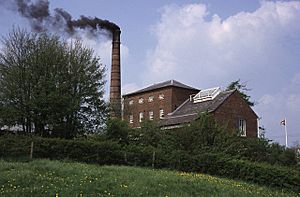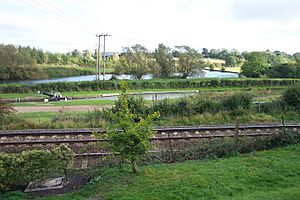Crofton Pumping Station facts for kids
Quick facts for kids Crofton Pumping Station |
|
|---|---|

The pumping station on a running day in 1999
|
|
| Type | Pumping station |
| Location | Crofton, Great Bedwyn, Wiltshire, England |
| OS grid reference | SU 2615 6227 |
| Built | 1807–1809 |
| Owner | Kennet and Avon Canal Trust |
|
Listed Building – Grade I
|
|
| Official name: Crofton Pumping Station | |
| Designated | 1 May 1985 |
| Reference no. | 1034049 |
| Lua error in Module:Location_map at line 420: attempt to index field 'wikibase' (a nil value). | |
Crofton Pumping Station is a special old building in Wiltshire, England. It helps keep the Kennet and Avon Canal full of water. This amazing place uses powerful steam engines to pump water up to the highest part of the canal.
It is one of the oldest working pumping stations in the world. Inside, you can see a Boulton & Watt steam engine from 1812. This engine is still in its original building and can still do the job it was built for! You can visit the station on certain weekends to see it in action.
Contents
How the Pumping Station Works
When the canal was first built, there wasn't enough water to fill its highest section naturally. But engineers found some springs about 1.6 kilometers (1 mile) away. These springs were about 12 meters (40 feet) lower than the canal's highest point.
The water from these springs flowed into the canal below lock 60. Later, a reservoir called Wilton Water was built to provide even more water. You can see this reservoir across the canal from the pumping station.
Pumping Water Uphill
Water from below lock 60 travels through a special underground pipe, called a culvert. This pipe leads to a well at the pumping station. The station itself is built on a hillside, more than 12 meters (40 feet) above the canal.
The powerful pumps lift the water from this well. Then, they push it into a channel right next to the station. From there, the water flows downhill by gravity for about 1.6 kilometers (1 mile). It finally reaches the highest part of the canal, called the summit pound.
Modern and Historic Pumps
Today, electric pumps usually do the work at Crofton. These pumps are controlled automatically by the water level in the canal. However, the original steam-powered equipment has been carefully saved and still works!
A large Lancashire boiler creates the steam needed to power the old engines.
- Engine Number 1: This engine was built by Boulton and Watt in 1812. It was later updated in the 1840s. It's a single-acting engine that can lift about 1,032 kilograms (2,274 pounds) of water with each stroke. It makes about 11 strokes per minute.
- Engine Number 2: This engine was built by Harvey and Co. in 1846. It was rebuilt in 1903. It's also a single-acting engine. It can lift about 1,014 kilograms (2,235 pounds) of water per stroke, making about 10.2 strokes per minute.
When the Great Western Railway built its train tracks, they went right past the pumping station. Now, to get from the canal to the station, you have to go through a small tunnel with a very low roof.
History of Crofton Pumping Station
The pumping station was built between 1807 and 1809. It was ready just in time for the canal to open in 1810. The building was designed for two engines, but only one was installed at first. This first engine was bought second-hand.
In 1810, a second engine was ordered from Boulton and Watt. This engine started working in 1812 and is the famous Number 1 engine we see today. It was the main engine for most of the station's steam-powered life.
In 1846, the first engine was replaced by a new one from Harvey and Co. However, this new engine caused problems and eventually stopped being used.
Restoring the Engines
In 1903, the 1846 engine was rebuilt and became the current Number 2 engine. Both engines worked regularly until the 1950s. At that time, part of the chimney had to be removed. The shorter chimney couldn't create enough "draught" (airflow) for the boiler. It became cheaper to use electric pumps instead of the steam engines.
In 1968, the Kennet and Avon Canal Trust bought the pumping station. They wanted to bring it back to life. The building and both engines were restored. The old boiler was replaced with another one of the same type.
Engine Number 1 was successfully steamed again on April 4, 1970. The pumping station officially reopened on August 21, 1970. Engine Number 2 was steamed for the first time after restoration on November 15, 1971.
The pumping station was recognized as a Grade I listed site in 1985, meaning it's a very important historic building.
At first, an electric fan helped the shorter chimney work. But between 1996 and 1997, the chimney was fully repaired and returned to its original height of 25 meters (82 feet).
In July 2009, the modern electric pumps at Crofton stopped working. While they were being fixed, the Kennet and Avon Canal Trust started up the old steam engines to keep the canal full.
In 2012, the Boulton and Watt engine celebrated its 200th birthday! Special steaming events were held, and even the Duke of Gloucester visited.
Visiting Crofton Pumping Station
The pumping station is open to visitors on certain days. You can see the amazing steam engines working during these special "steaming days."
See also
- Claverton Pumping Station, another restored pumping station on the Kennet and Avon canal




